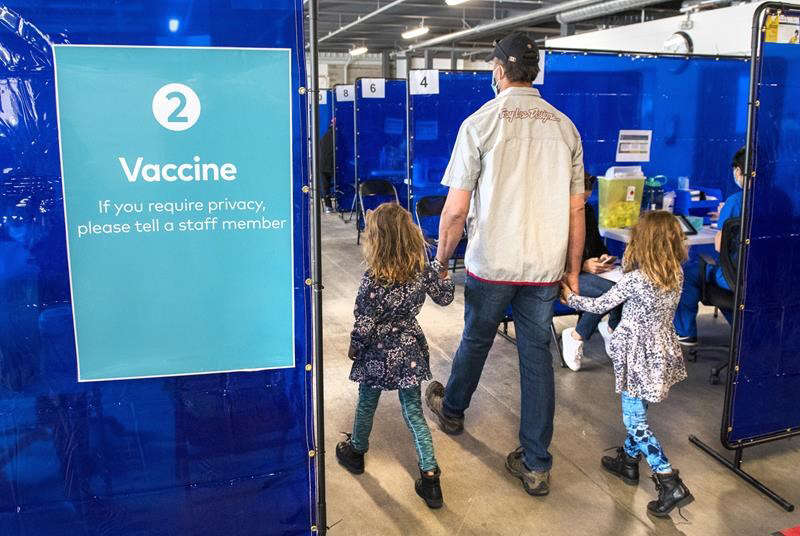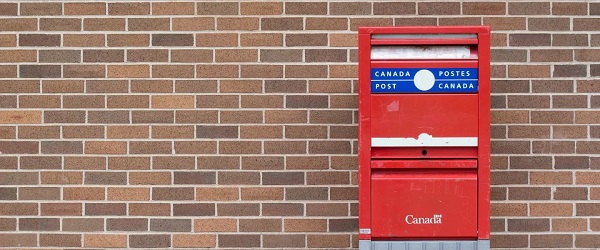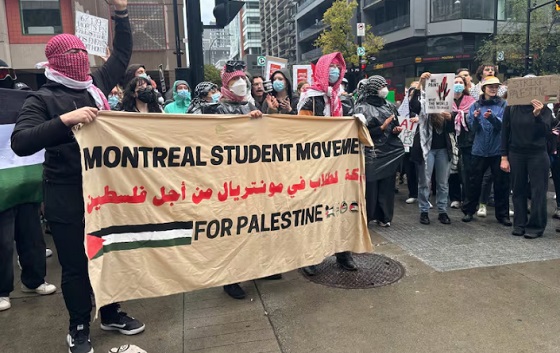COVID-19
Mask, vaccine mandates for travel defended as government eases border restrictions

OTTAWA — The government signalled it is aspiring to a “more sustainable” approach to COVID-19 restrictions at the border with several small changes Friday, but public health officials say vaccine and mask mandates remain important.
Unvaccinated children aged five to 11 travelling with a fully vaccinated adult will no longer need a COVID-19 test to enter Canada as of Monday.
Pre-entry tests will still be needed for partially vaccinated or unvaccinated travellers over the age of 12 who are eligible to travel to Canada.
Children under five don’t currently require a COVID-19 test.
Airports will still conduct random mandatory COVID-19 tests on travellers as they arrive, but they will be refocused to four major Canadian airports: Vancouver, Calgary, Toronto and Montreal.
In a news release Friday, government officials announced several other small changes to ease restrictions for international travellers that will take effect after the weekend, “as of part of the Government of Canada’s plans to move toward a more sustainable approach to COVID-19 travel requirements.”
Fully vaccinated travellers, and any kids under 12 with them, will no longer need to provide their quarantine plans when they enter the country.
And when vaccinated people arrive in Canada, they won’t need to wear a mask for 14 days, keep a list of contacts or report COVID-19 symptoms.
The government will also do away with the need for fully vaccinated travellers to quarantine if someone in their group develops COVID-19 symptoms or tests positive.
It’s a good time to ease restrictions at the border, deputy chief public health officer Dr. Howard Njoo said at a briefing in French Friday.
“If people are fully vaccinated, measures can be relaxed,” Njoo said in French.
The minor changes come as particularly good news for people travelling as a family this season, said National Airlines Council of Canada president Suzanne Acton-Gervais.
While Njoo and his chief, Dr. Theresa Tam, said restrictions should be constantly reviewed they also expressed support for the vaccine and mask mandates that are in place.
“I’m not saying anything about it from a policy perspective, but yes, the higher our vaccination rate is, the higher the uptake is of vaccines, the better overall,” Njoo said.
Health Minister Jean-Yves Duclos did not appear at the press briefing, but said in a statement that the government would continue to consider further easing of border measures based on science as vaccination levels and health-care system capacity improve.
Airlines in the United States dropped their mask mandates after a Florida judge ruled that the Centers for Disease Control and Prevention overstepped its authority in enacting the mandate on public transportation in the first place.
Combined with the fact that many provinces have announced plans to scrap their own mandates, that has prompted some to question whether Canadians should have to mask up on planes and trains.
Tam said if a mandate will encourage people to wear a mask and reduce transmission, why not have one?
“I mean, it has a certain amount of inconvenience perhaps, but it does not essentially restrict travel as such. So I think it’s one of the least intrusive measures, but adds definitely another layer of protection,” Tam said.
Transportation Minister Omar Alghabra says federal and provincial COVID-19 mandates are not out of step with each other at all.
“I actually think the federal rules and provincial rules are almost in sync,” he said at a separate press conference Friday.
“We’ve dropped testing requirements, we’ve dropped quarantine requirements, pre-departure tests. So we’ve really adjusted many of our measures.”
Ontario announced Friday it will extend its mask requirement in high-risk settings until June 11 while it weathers this latest wave of infections.
Tam said COVID-19 is still widespread throughout Canada, and the current wave appeared to be reaching a peak in some parts of the country before the Easter long weekend. It’s too soon to tell if gatherings over that long weekend will result in another bump in cases, she said.
Generally, the number of hospitalizations appears to be manageable during this wave, though some hospitals are suffering as health workers take time off because of COVID-19 infections, she said.
This report by The Canadian Press was first published April 22, 2022.
Laura Osman, The Canadian Press
COVID-19
The Trials of Liberty: What the Truckers Taught Canada About Power and Protest

Half the country still believes the convoy was a menace; the other half thinks it was a mirror that showed how fragile our freedoms had become.
This Thanksgiving I am grateful for many things. The truckers who stood up to injustice are among them.
When the first rigs rolled toward Ottawa in January 2022, the air was sharp, but not as sharp as the mood of the men and women behind the wheels. They were not radicals. Seeing a CBC a campaign of disinformation about them begin as soon as their trek started, even when Ottawa political operatives hadn’t yet heard, I started following several of them on their social media.
They were truckers, small business owners, independent contractors, and working Canadians who had spent two years hauling the essentials that kept a paralyzed nation alive. They were the same people politicians, including Prime Minister Trudeau, had called “heroes” in 2020. By 2022, they had become “threats.”
The Freedom Convoy was born from exhaustion with naked hypocrisy. The federal government that praised them for risking exposure on the road now barred the unvaccinated from crossing borders or even earning a living. Many in provincial governments cheered Ottawa on. The same officials who flew to foreign conferences maskless or sat in private terraces to dine, let’s recall, still forced toddlers to wear masks in daycare. Public servants worked from home while police fined citizens for walking in parks.
These contradictions were not trivial; they were models of tyrannical rule. They told ordinary people that rules were for the ruled, not for rulers.
By late 2021, Canada’s pandemic response had hardened into a hysterical moral regime. Compliance became a measure of virtue, not prudence. Citizens who questioned the mandates were mocked as conspiracy theorists. Those who questioned vaccine efficacy were treated as fools; those who refused vaccination were treated as contagious heretics. Even science was no longer scientific. When data showed that vaccines did not prevent transmission, officials changed definitions instead of policies. The regime confused authority with truth. One former provincial premier just this week was still hailing the miracle of “life-saving” COVID vaccines.
For truckers, the breaking point came with the federal vaccine mandate for cross-border transport. Many had already complied with provincial rules and workplace testing. Others had recovered from COVID and had natural immunity that the government refused to recognize. To them, the new rule was not about safety; it was about humiliation. It said, “Obey, or you are unfit to work.”
So they drove.
Donna Laframboise, one of the rare journalists who works for citizens instead of sponsors, described the convoy in her book Thank You, Truckers! with gratitude and awe. She saw not a mob but a moral statement. She showcased for us Canadians who refused to live by lies. Their horns announced what polite society whispered: the emergency had become a creepy habit, and the habit had become a tool of control.
When the convoy reached Ottawa, it was messy, loud, and human. There was singing, prayer, laughter, dancing and some foolishness, but also remarkable discipline. For three weeks, amid frigid temperatures and rising tension, there were no riots, no arsons, no looting. In a country that once prized civility, that should have earned respect.
Instead, it attracted the media’s and government’s contempt.
The Trudeau government, rattled by its own public failures, sprung to portray the protest as a national security threat. Ministers invoked language fit for wartime. The Prime Minister, who had initially fled the city claiming to have tested positive, returned to declare that Canadians were under siege by “racists” and “misogynists.” The accusations were as reckless as they were false. The government’s real grievance was not chaos but defiance.
Then came the Emergencies Act. Designed for war, invasion, or insurrection, it was now deployed against citizens with flags and thermoses. Bank accounts were frozen without charge or trial. Insurance policies were suspended. Police weilding clubs were unleashed against unarmed citizens. The federal government did not enforce the law; it improvised it.
A faltering government declared itself the victim of its citizens. The Emergency declaration was not a reaction to danger; it was a confession of political insecurity. It exposed a leadership that could not tolerate dissent and recast obedience for peace.
Haultain Research is a reader-supported publication.
To receive new posts, express your gratitude and support our work, consider becoming a a paid subscriber.
The convoy’s organizers, who kept the protest largely peaceful, were arrested and prosecuted as though they had plotted sedition. They were charged for holding the line, not for breaking it. The state’s behaviour was vindictive, not judicial. Prosecutors went along with it, and so did courts.
In a healthy democracy, such political trials would have shaken Parliament to its core. Legislators would have demanded justification for the use of emergency powers. The press would have asked precisely which law had been broken. Citizens would have debated the limits of government in times of fear, times which seem to continue just under the radar.
Not much of that happened.
Canada’s institutions have grown timid. The press is subsidized and more subservient. The courts happily defer to the administrative state. Law enforcement has learned to follow politics before principle. Academics have been lost for about generation. Under such conditions, how can citizens object to unscientific and coercive policies? What options remain when every channel of dissent—media, science, judiciary, and law enforcement—is captured or cowed?
The convoy’s protest, let’s remember, was not the first major disruption in the Trudeau years. A year earlier, Indigenous activists blocked rail lines and highways in solidarity with Wet’suwet’en hereditary chiefs opposed to a pipeline. The blockades cost the economy millions. They were called “a national conversation.” Few arrests, no frozen accounts, no moral panic.
In 2020, Black Lives Matter marches were cheered by politicians and news anchors. Some protests were peaceful, others destructive. Yet they were treated as expressions of justice, not extremism.
Even today, pro-Hamas Palestinian demonstrations that include violence and intimidation of Jewish citizens are tolerated with a shrug. The police stand back, bring them coffee, citing “the right to protest.”
Why, then, was the Freedom Convoy treated as a crisis of state?
In a liberal democracy, protest is not rebellion. It is a civic instrument, a reminder that authority is contingent. When a government punishes peaceful protest because it disapproves of the message, it turns democracy into décor.
The trials of the convoy organizers are therefore not about law but about legitimacy. Each conviction signals that protest is permitted only when it pleases the powerful. This is the logic of every soft tyranny: it criminalizes opposition while decorating itself with the vocabulary of rights. I see this daily in Nicaragua, my native land.
The truckers’ protest revealed what the pandemic concealed. The COVID regime was unscientific and incoherent. It punished truckers who worked alone in their cabs while allowing politicians to mingle maskless at conferences. It barred unvaccinated Canadians from air travel but allowed infected citizens to cross borders with the proper paperwork. It closed playgrounds and churches while keeping liquor stores open.
These contradictions were not mistakes; they were instruments of obedience. Each absurd rule tested how much submission people would endure.
The truckers said, “Enough.” I am grateful that they did.
For that, Chris Barber (Big Red) and Tamara Lich  are still being punished. Their trials have now concluded, save for possible appeals, yet their quiet defiance remains one of the few honest moments in recent Canadian history. It showed that courage is still possible, even the state seems to forbid reason.
are still being punished. Their trials have now concluded, save for possible appeals, yet their quiet defiance remains one of the few honest moments in recent Canadian history. It showed that courage is still possible, even the state seems to forbid reason.
The government’s response revealed the opposite: that fear, once politicized, is never surrendered willingly. The state that learned to rule through emergency will not soon unlearn it. They cling to its uses still.
Canada lives with the legacy of that winter today. The trials are finished, but the divisions persist. Half the country still believes the convoy was a menace; the other half thinks it was a mirror that showed how fragile our freedoms had become.
Trudeau’s government is no more, yet the spirit of his politics lingers. He did not create the divisions by accident. He cultivated them as a strategy of control. The country that left him behind is also less free, less trusting, and less united than it was before the horns sounded in Ottawa. Carney’s government is Trudeau’s heir.
The trials and sentencing measure the distance between the Canada we imagined and the one we inhabit.
The truckers’ convoy was imperfect, yet profoundly democratic. It stood for the right of citizens to say no to a government that had forgotten how to hear them. The echo of that refusal still moves down the Trans-Canada Highway. It is the sound of liberty idling in the cold, waiting for a green light that will not soon come.
This Thanksgiving, I am grateful for the abounding love and understanding in my life. I am grateful for my spirited children and their children. I am grateful for my nonagenarian father and for my siblings. I’m grateful for the legion of aunts, uncles, cousins, nieces and nephews on all sides of the family. I am grateful for loyal friendships and for my colleagues and coworkers who share the quest for a freer country. I’m grateful to my adoptive Alberta, and Albertans, also struggling to be strong and free.
I am grateful for the Truckers, wherever they came from, for their courage.
Haultain Research is a reader-supported publication.
To receive new posts, express your gratitude and support our work, consider becoming a a paid subscriber.
COVID-19
Devastating COVID-19 Vaccine Side Effect Confirmed by New Data: Study

The Vigilant Fox
In one of the greatest violations of medical ethics in modern history, a new study from South Korea has uncovered devastating consequences from promoting and mandating the COVID-19 injections on the population.
These shots were pushed on babies and pregnant women, directly contradicting the ethical rule against introducing new medical interventions to such vulnerable groups before long-term effects are fully understood.
But they weren’t just aggressively promoted; they were enforced. Refusing the COVID-19 injection could cost you your job, bar you from concerts, businesses, and museums, and, in some cases, even deny you a life-saving surgery unless you complied with the mandate.
Now, as many doctors long warned, the consequences of such reckless health policy are surfacing, and one of the most alarming outcomes is a dramatic rise in cancer risk.
A large-scale population study out of South Korea has now found a 27% overall increase in cancer linked to the COVID-19 injections that were marketed as “safe and effective.”
Dr. John Campbell noted: “There’s a one in a thousand chance that this result arose by chance.” He illustrated the overall cancer rise with a stark graph, as seen in the short video below:
With regard to the details of the study, Children’s Health Defense reports:
The study used data from 2021–2023 for over 8.4 million people in South Korea’s National Health Insurance Service database. The sample was split into two groups based on vaccination status. The vaccinated sample was further split into booster and non-booster groups.
Researchers tracked the patients for one year. The vaccinated group was tracked following vaccination. The results showed a statistically significant higher risk of cancer in the vaccinated group, including:
• Overall cancer: 27% higher risk
• Breast cancer: 20% higher risk
• Colorectal cancer: 28% higher risk
• Gastric cancer: 34% higher risk
• Lung cancer: 53% higher risk
• Prostate cancer: 69% higher risk
• Thyroid cancer: 35% higher risk
These results are nothing short of devastating. Our worst fears have become reality.
And the worst part is that it didn’t have to be this way. Health officials ignored caution, silenced dissent, and turned public health into a reckless experiment.
Now the consequences of such reckless policies have turned the COVID wave into a health tsunami. The longer this issue is ignored, the greater the damage will become. It’s time for health officials to take responsibility for what they’ve done.
-

 Opinion2 days ago
Opinion2 days agoJordan Peterson needs prayers as he battles serious health issues, daughter Mikhaila says
-

 COVID-192 days ago
COVID-192 days agoDevastating COVID-19 Vaccine Side Effect Confirmed by New Data: Study
-

 Censorship Industrial Complex2 days ago
Censorship Industrial Complex2 days agoWinnipeg Universities Flunk The Free Speech Test
-

 Red Deer1 day ago
Red Deer1 day agoThe City of Red Deer’s Financial Troubles: Here Are The Candidates I Am Voting For And Why.
-

 Crime2 days ago
Crime2 days agoThe Bureau Exclusive: Chinese–Mexican Syndicate Shipping Methods Exposed — Vancouver as a Global Meth Hub
-

 Crime2 days ago
Crime2 days agoCanadian Sovereignty at Stake: Stunning Testimony at Security Hearing in Ottawa from Sam Cooper
-

 Business1 day ago
Business1 day agoCanada Post is failing Canadians—time to privatize it
-

 Haultain Research2 days ago
Haultain Research2 days agoInclusion and Disorder: Unlearned Lessons from Palestinian Protests












